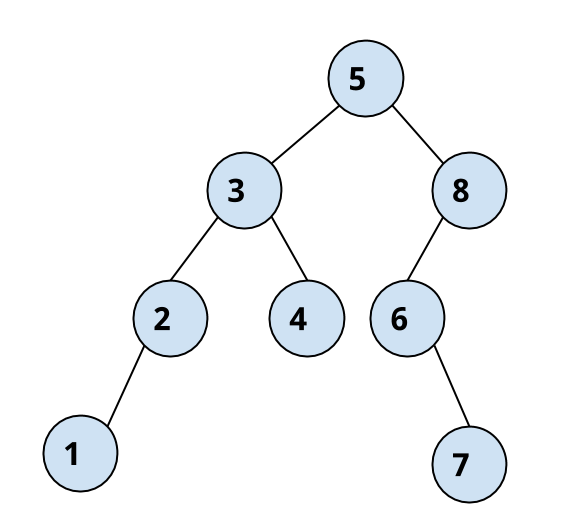A binary search tree is a hierarchical data structure which stores data in a non-linear fashion. It supports the insertion, search and deletion operations in O( log n ) time. Take a look at the below picture.
This is an example of binary search tree. The node at the top containing 5 is the root and all the elements to the left of it(left sub-tree) are less than 5 and all the elements to the right of it (right sub-tree) are greater than 5. A binary search tree does not allow duplicate elements in it.
In this post we see how an insertion method works. It works very similar to the binary search.
The insert method looks at the root. If the given data is lesser than root data, it has to be inserted into the left sub-tree. Otherwise it has to be added in the right sub-tree. Since the left/right sub-trees are also binary search trees, we call the procedure recursively.
Here is the complete C++ program which implements a binary search tree in Object Oriented approach. I have used in-order traversal to print all the elements of the binary search tree. These procedures are explained in future posts.
This file contains hidden or bidirectional Unicode text that may be interpreted or compiled differently than what appears below. To review, open the file in an editor that reveals hidden Unicode characters.
Learn more about bidirectional Unicode characters
| #include <iostream> | |
| using namespace std; | |
| //Define binary search tree node | |
| class BSTNode | |
| { | |
| int data; | |
| BSTNode *left; | |
| BSTNode *right; | |
| public: | |
| //single param constructor | |
| BSTNode(int d):data(d), left(NULL), right(NULL) | |
| { | |
| } | |
| BSTNode(int d, BSTNode *l, BSTNode *r):data(d), left(l), right(r) | |
| { | |
| } | |
| int getData() | |
| { | |
| return data; | |
| } | |
| void setData(int d) | |
| { | |
| data = d; | |
| } | |
| BSTNode* getLeft() | |
| { | |
| return left; | |
| } | |
| void setLeft(BSTNode *l) | |
| { | |
| left = l; | |
| } | |
| BSTNode* getRight() | |
| { | |
| return right; | |
| } | |
| void setRight(BSTNode *r) | |
| { | |
| right = r; | |
| } | |
| }; | |
| //Define the binary search tree itself | |
| class BinarySearchTree | |
| { | |
| BSTNode * root; | |
| public: | |
| BinarySearchTree():root(NULL) | |
| { | |
| } | |
| BSTNode * getRoot() | |
| { | |
| return root; | |
| } | |
| bool insert(int d) | |
| { | |
| if( root == NULL ) // if tree is empty | |
| { | |
| root = new BSTNode(d); | |
| return true; | |
| } | |
| else | |
| { | |
| BSTNode *ptr = root; | |
| BSTNode *prev = NULL; | |
| while( ptr != NULL ) | |
| { | |
| prev = ptr; | |
| if( ptr->getData() == d )//no duplicates allowed in BST | |
| return false; | |
| else if( ptr->getData() < d ) | |
| { | |
| ptr = ptr->getRight();// go to right sub-tree | |
| } | |
| else | |
| { | |
| ptr = ptr->getLeft();// go to left sub-tree | |
| } | |
| } | |
| if( prev->getData() < d ) //to be added as right child? | |
| prev->setRight( new BSTNode(d) ); | |
| else | |
| prev->setLeft( new BSTNode(d) ); | |
| return true; | |
| } | |
| } | |
| //prints all the elements in binary tree in left - root - right order | |
| void inorder(BSTNode *root) | |
| { | |
| if( root ) | |
| { | |
| inorder( root->getLeft() ); | |
| cout<< root->getData() << " "; | |
| inorder( root->getRight() ); | |
| } | |
| } | |
| }; | |
| int main() | |
| { | |
| BinarySearchTree *bst = new BinarySearchTree(); | |
| bst->insert(5); | |
| bst->insert(3); | |
| bst->insert(8); | |
| bst->insert(4); | |
| bst->insert(9); | |
| bst->insert(1); | |
| bst->insert(10); | |
| bst->insert(2); | |
| bst->insert(6); | |
| bst->insert(7); | |
| //in-order traversal should print the elements in ascending order | |
| bst->inorder( bst->getRoot() ); | |
| cout << endl; | |
| return 0; | |
| } |

 by
by